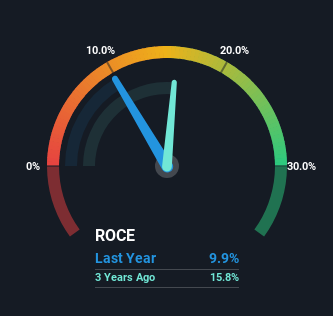- Japan
- /
- Auto Components
- /
- TSE:3116
Toyota Boshoku (TSE:3116) Will Be Hoping To Turn Its Returns On Capital Around
There are a few key trends to look for if we want to identify the next multi-bagger. Ideally, a business will show two trends; firstly a growing return on capital employed (ROCE) and secondly, an increasing amount of capital employed. If you see this, it typically means it's a company with a great business model and plenty of profitable reinvestment opportunities. However, after briefly looking over the numbers, we don't think Toyota Boshoku (TSE:3116) has the makings of a multi-bagger going forward, but let's have a look at why that may be.
Return On Capital Employed (ROCE): What Is It?
If you haven't worked with ROCE before, it measures the 'return' (pre-tax profit) a company generates from capital employed in its business. The formula for this calculation on Toyota Boshoku is:
Return on Capital Employed = Earnings Before Interest and Tax (EBIT) ÷ (Total Assets - Current Liabilities)
0.099 = JP¥73b ÷ (JP¥1.1t - JP¥400b) (Based on the trailing twelve months to June 2024).
Thus, Toyota Boshoku has an ROCE of 9.9%. On its own that's a low return, but compared to the average of 6.2% generated by the Auto Components industry, it's much better.
View our latest analysis for Toyota Boshoku

Above you can see how the current ROCE for Toyota Boshoku compares to its prior returns on capital, but there's only so much you can tell from the past. If you'd like, you can check out the forecasts from the analysts covering Toyota Boshoku for free.
How Are Returns Trending?
On the surface, the trend of ROCE at Toyota Boshoku doesn't inspire confidence. To be more specific, ROCE has fallen from 13% over the last five years. Although, given both revenue and the amount of assets employed in the business have increased, it could suggest the company is investing in growth, and the extra capital has led to a short-term reduction in ROCE. And if the increased capital generates additional returns, the business, and thus shareholders, will benefit in the long run.
The Bottom Line On Toyota Boshoku's ROCE
In summary, despite lower returns in the short term, we're encouraged to see that Toyota Boshoku is reinvesting for growth and has higher sales as a result. Furthermore the stock has climbed 41% over the last five years, it would appear that investors are upbeat about the future. So while the underlying trends could already be accounted for by investors, we still think this stock is worth looking into further.
One more thing, we've spotted 1 warning sign facing Toyota Boshoku that you might find interesting.
While Toyota Boshoku isn't earning the highest return, check out this free list of companies that are earning high returns on equity with solid balance sheets.
Valuation is complex, but we're here to simplify it.
Discover if Toyota Boshoku might be undervalued or overvalued with our detailed analysis, featuring fair value estimates, potential risks, dividends, insider trades, and its financial condition.
Access Free AnalysisHave feedback on this article? Concerned about the content? Get in touch with us directly. Alternatively, email editorial-team (at) simplywallst.com.
This article by Simply Wall St is general in nature. We provide commentary based on historical data and analyst forecasts only using an unbiased methodology and our articles are not intended to be financial advice. It does not constitute a recommendation to buy or sell any stock, and does not take account of your objectives, or your financial situation. We aim to bring you long-term focused analysis driven by fundamental data. Note that our analysis may not factor in the latest price-sensitive company announcements or qualitative material. Simply Wall St has no position in any stocks mentioned.
About TSE:3116
Toyota Boshoku
Develops, manufactures, and sells automotive interior systems in Japan, the United States, China, and internationally.
Flawless balance sheet established dividend payer.
Similar Companies
Market Insights
Community Narratives




